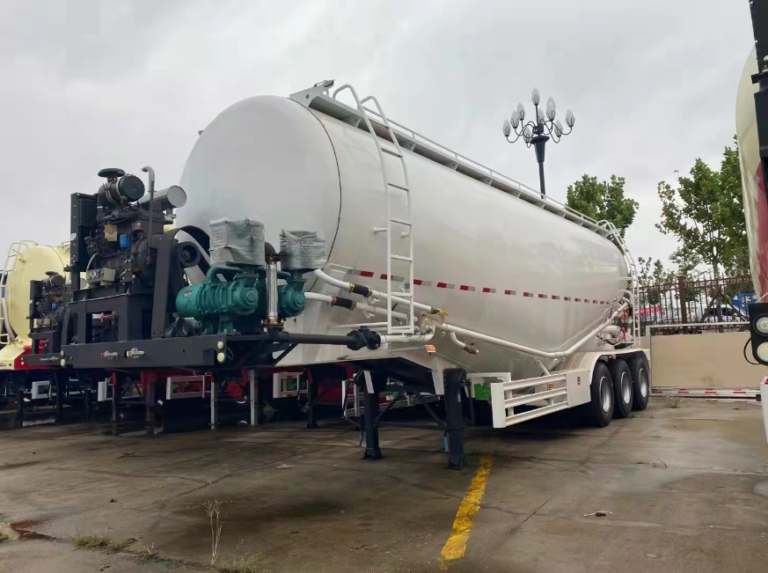1. End Dump: This type of cement tank trailer has a dump gate at the end of the trailer, allowing for quick and easy unloading of material.
2. Pneumatic: This type of cement tank trailer is equipped with an air-powered system, allowing for the material to be unloaded quickly and efficiently.
3. Side Dump: This type of cement tank trailer has a dump gate on the side of the trailer, allowing for easy and efficient unloading of material.
4. Bottom Dump: This type of cement tank trailer has a dump gate at the bottom of the trailer, allowing for quick and easy unloading of material.
5. Roll-Off: This type of cement tank trailer is equipped with a roll-off system, allowing for the material to be unloaded quickly and efficiently.
Cement tanker trailer types
According to loading media
1. Cement Bulk trailer: This type of trailer is designed for the transportation of dry bulk cement, such as fly ash, lime, and gypsum. It is usually equipped with a blower or compressor for unloading the materials.
2. Liquid Cement Tanker Trailer: This type of trailer is designed for the transportation of liquid cement. It is usually equipped with a pump and other necessary components for unloading the materials.
3. Pneumatic Cement Tanker Trailer: This type of trailer is designed for the transportation of both dry bulk and liquid cement. It is equipped with a blower or compressor and a pump for unloading the materials.
Cement tank trailer Structures
A cement tank trailer is a trailer designed to carry bulk cement or other dry bulk materials. It typically consists of a steel or aluminum frame with a tank body mounted on top. The tank body is usually cylindrical in shape and may be insulated or uninsulated. The frame may also have additional components such as axles, suspension systems, brakes, and lights. The tank body may be equipped with valves, pumps, and other equipment for loading and unloading the material.
When will use the cement tank trailer
Cement tank trailers are typically used for transporting large quantities of cement to construction sites, factories, and other locations. They are also used for hauling dry bulk materials such as sand, gravel, and other aggregate materials. China Cement trailer carrier are most commonly used for long-distance hauls, as they are able to store large amounts of material and are designed to be able to handle the weight of the material being transported.
What is the cement tank trailer mainly used for?
Cement tank trailers are mainly used for the transportation of bulk cement or dry bulk materials such as fly ash, lime powder, and dry mortar. They are typically used by construction companies, cement factories, and other industries that require the transportation of bulk materials from one location to another.
How many cement packets can a bulk cement trailer carry?
The capacity of a bulk cement trailer varies depending on the size of the trailer, but typically they can carry between 30,000 and 40,000 pounds (13,608 to 18,144 kilograms) of cement. This is equivalent to between 6,000 and 8,000 cement packets.
Why are bulk cement carrier trailers v-shaped?
Bulk cement carrier trailers are V-shaped because this shape helps to evenly distribute the weight of the cement and prevent the trailer from tipping over. The V-shape also helps to reduce the amount of air resistance, which can help to improve fuel efficiency.
How to use cement bulker safely?
1. Wear appropriate safety gear, including a hard hat, protective goggles, and a face mask.
2. Check the cement bulker for any damage or loose parts before use.
3. Make sure the area around the cement bulker is clear and free from obstructions.
4. Secure the bulker to the ground or other support structure to ensure it doesn’t move while in use.
5. Connect the hoses and other components properly.
6. Follow the manufacturer’s instructions for use and maintenance.
7. Ensure all personnel are aware of the safety precautions and procedures.
8. Monitor the cement bulker during use and stop it immediately if any problems arise.
9. Disconnect the hoses and other components after use and store them properly.
10. Regularly inspect the cement bulker for any signs of wear or damage.
